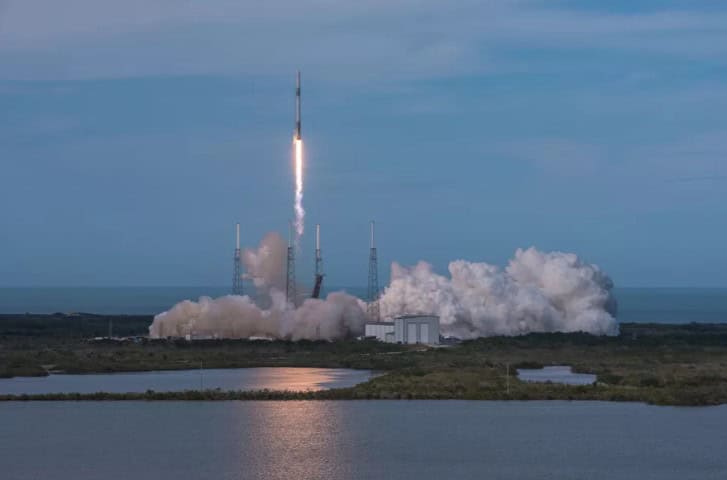
Early Friday morning, SpaceX will launch its 15th cargo mission to the International Space Station for NASA, sending up nearly 6,000 pounds of supplies on top of its Falcon 9 rocket. On board the vehicle are shipments of food and water for the six astronauts living on the ISS, as well as new science experiments and technologies to be tested out in microgravity. And within that haul includes the first ever AI robot “crew member” to live on the station.
The robot’s name is CIMON — for Crew Interactive Mobile Companion — and it looks a bit like a volleyball with a computer screen on one side. The screen displays a simplified cartoon face that the bot will use to interact with the humans on the ISS. And to maneuver around, CIMON is equipped with 14 internal fans that propel the white ball, by sucking in the station’s air and expelling it to move in whatever direction it needs. That means CIMON can “float” throughout the station, zooming up to astronauts that call its name and nodding in response to questions.
Airbus developed CIMON for Germany’s national space agency, and the goal is to see whether intelligent bots can cooperate with astronauts to simplify work life in space. CIMON’s already been tested out on a parabolic flight — an airplane that flies a special trajectory to create brief moments of weightlessness. And CIMON has trained a few times on Earth with German astronaut Alexander Gerst, who is already on board the ISS. So the bot’s microphones and cameras are specially tuned to recognize his voice and face. However, CIMON’s makers say the bot’s voice-controlled AI capabilities, provided by IBM, allow the companion to interact with any astronaut that calls its name.
/cdn.vox-cdn.com/uploads/chorus_asset/file/11615705/CIMON6_sn.jpg)
Once on the station, Gerst will greet CIMON and use the bot for help with a couple science experiments. For example, CIMON can walk Gerst through a complex procedure with the help of pictures and videos it can display on its screen. Gerst can also ask CIMON questions about the experiments he will be working on. CIMON is meant to simply test out this AI companion technology, so the bot will only interact with Gerst and other crew members for three hours total on the station. But what it learns could help inform the design of similar AI bots in the future.
Along with CIMON, SpaceX is also sending up an instrument that will be attached to the outside of the ISS to measure the temperatures of plants on Earth. These measurements can tell scientists how stressed out our planet’s ecosystems are and if the world’s plants are receiving enough water. Additionally, SpaceX will carry up an extra latching mechanism that can attach to the end of Canada’s robotic arm on the outside of the space station. The arm, which is a long snakelike robot, has had two of these mechanisms on either end for the last 17 years. But Canada’s space agency has noticed some wear and tear on the mechanisms over time, and one of the latches actually failed in fall 2017. Canada has since replaced the mechanisms with spares, but the country is sending up another one just in case there’s another failure.
SpaceX is employing a used Falcon 9 rocket for this mission, as well as a used Dragon cargo capsule to carry all of the supplies to the ISS. It marks the third time the company has flown both a refurbished Dragon and Falcon 9 for NASA. The Dragon previously flew to the space station in July of 2016, while the Falcon 9 flew in April of this year, when it launched a new planet-hunting satellite for NASA called TESS. The rocket landed on one of SpaceX’s drone ships after take off, and the company was able to make the vehicle flight-ready again in just two and a half months. That’s the shortest turnaround time needed for a Falcon 9 rocket yet. “Our teams have gotten extremely efficient at the refurbishment process,” Jessica Jensen, director of Dragon mission management at SpaceX, said at a press conference before the mission.
However, SpaceX won’t attempt to land this Falcon 9 after liftoff. This mission will be the last launch of SpaceX’s Falcon 9 Block 4, on older version of the rocket that the company is phasing out. After this flight, all of SpaceX’s future Falcon 9 launches will be on the Block 5 — the final and most powerful upgrade of the rocket that makes it even easier to land and reuse. The Block 5 is also the rocket that SpaceX will use to launch NASA astronauts to the ISS as part of the agency’s Commercial Crew Program.
SpaceX’s Falcon 9 is scheduled to take off from Cape Canaveral Air Force Station in Florida at 5:42AM ET on Friday, and the Dragon is set to rendezvous with the space station three days later on Monday at around 7AM ET. The company has an instantaneous launch window, though, so if it doesn’t take off right on time tomorrow, it’ll have to try again another day. A backup launch date is set for Sunday, July 1st at 4:54AM ET. However, weather is looking good for a Friday launch, with a 90 percent chance of favorable conditions.
NASA’s coverage of the launch will begin on NASA TV at 5:15AM ET, while SpaceX’s coverage will begin around 20 minutes before liftoff.

